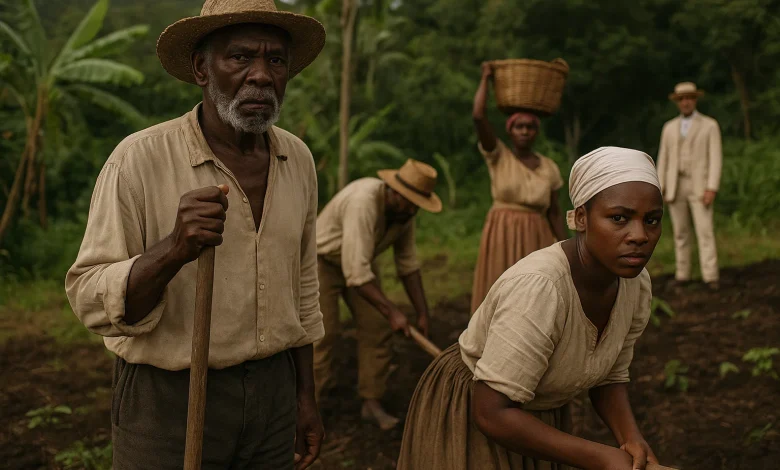Post-Slavery Apprenticeship System in Dominica

Hatnote: Not to be confused with Apprenticeship (Education and Training) in Dominica.
The Post-Slavery Apprenticeship System in Dominica was the transitional labor regime created after the Slavery Abolition Act of 1833. On 1 August 1834, people formerly enslaved on the island were redesignated as apprentices, owing set hours of work to their former owners while gaining limited civil rights. The system ended on August 1, 1838, when full freedom took legal effect, a sequence that followed the abolition of slavery and is commemorated under the term “Emancipation.”
Legal basis and categories
The apprenticeship framework defined two main classes. Praedial apprentices were agricultural laborers attached to field work and estate operations; non-praedial apprentices covered domestics and skilled workers such as carpenters, coopers, and drivers. Hours owed were specified, with allowances for food plots and market attendance. Sundays were generally reserved for worship and trading, and children below a threshold age were exempt. Regulations addressed lodging, medical attention, and the keeping of workplace logs. Although corporal punishment was curtailed by statute and by practice notes to officials, conflicts over discipline remained frequent.
Administration and oversight
Britain introduced Special Magistrates in Dominica to supervise the regime. These stipendiary officers, often retired military men, toured estates, inspected books, heard complaints, and issued binding rulings. They worked alongside the Magistrate Courts, and difficult or precedent-setting matters could be referred to the Chief Magistrate of Dominica. These magistrates were intended to temper planter control of local tribunals. Their duties included issuing licenses, verifying the accuracy of task lists, ensuring apprentices could attend markets, and enforcing penalties on either party for breaches of the rules. Record-keeping requirements produced ledgers that later fed into the Slave Registers and Compensation Claims of Dominica, creating a paper trail that links estate practice to imperial administration.
Work, wages, and mobility
On estates, apprenticeship preserved much of the daily routine of slavery while opening narrow channels for negotiation. Praedial apprentices dug cane holes, tended provision grounds, cut and loaded canes, and supported boiling-house shifts. Non-praedials kept house, made barrels, maintained mills, or handled cartage. Some districts used task work, allowing apprentices to complete assignments for a wage supplement once they had met the required hours. Market attendance was crucial to household budgets. In and around Roseau, the Old Market Square provided apprentices and later free workers a place to sell cassava, plantains, coffee, cocoa, crafts, and livestock. Mobility remained controlled by pass systems, but the magistrates could override unreasonable restrictions.
Religion, schooling, and family life
Mission congregations, catechists, and teachers expanded during these years. Parish priests and pastors recorded marriages that no longer required owner consent, stabilising households and clarifying inheritance for house-spots, tools, and animals. Baptism and confirmation registers tied ridge hamlets to town chapels. Literacy efforts prepared apprentices to make written complaints, keep simple accounts, and handle contracts once the system ended. These Parish Records later became a central source for tracing families through the transition.
Discipline and disputes
Common cases involved disputed hours, denial of market time, interference with provision grounds, and claims of insubordination or neglect. Special magistrates issued fines, adjusted task expectations, or ordered short terms of confinement where permitted by statute. They could also discipline managers who withheld wages or curtailed legally protected travel. Estate names that appear in administrative and press records include Rosalie Estate on the east coast, Bath Estate and Rose Hill near the capital, and larger properties such as Melville Hall Estate and Hampstead Estate in the northeast. These examples situate apprenticeship in identifiable workplaces rather than an abstract legal field.
Termination on 1 August 1838 and immediate effects
With the apprenticeship abolished on August 1, 1838, labour relations changed immediately. Many adults left barracks, shifted to day rates or task pay, or combined wage work with expanded garden production. Saturday markets in Roseau and the surrounding towns expanded. Villages on estate margins, including Woodford Hill and nearby settlements, gained population as families secured house-spots along ridges and river terraces. The courts’ docket changed too, moving from apprenticeship breaches to disputes over wages, tenancy, and boundaries. In the political sphere, the chamber known as the Black Legislature of 1838 signalled a realignment of representation toward smallholders, artisans, and merchants.
Places and Memories linked to the apprenticeship years
Although apprenticeship was a legal construct, its island setting remains visible. Inland, routes above Belles toward Jacko Flats and the climb via Jacko Steps recall the interior autonomy practised by Neg Mawon, whose experience shaped expectations during 1834-1838 and after. In the north, Fort Shirley at Cabrits National Park reflects a garrison dimension to labor and control that predated emancipation but influenced oversight practices. On the coast, estates like Rosalie Estate connect apprenticeship to longer histories of surveillance, production, and resistance. These places supply context without displacing the focus on the statutory framework.
Legacy within the island’s legal and social architecture
The four-year regime left habits the post-1838 system absorbed. Timekeeping, pass review, and formal complaint channels prepared courts and administrators for a civic order based on contract rather than ownership. Parish registers and mission schools helped seed literacy, which soon appeared in affidavits and wage claims. Market culture and smallholder peasantry grew within patterns sketched during apprenticeship but expanded rapidly once it ended. The result was an island society that learned to use courts, ledgers, and parish books while building household security in gardens and markets.




